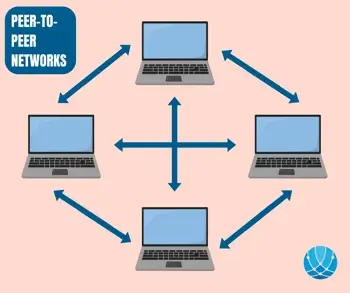What is P2P Network? | Peer-to-Peer Network Explained
When we discuss how devices exchange data, one key concept is how they share resources. One way to achieve this is through Peer-to-Peer (P2P) networks. In a P2P setup, devices communicate directly instead of going through a central server, streamlining operations, reducing cost, and improving connectivity. In this article, learn how a P2P network works and the advantages of using one.
What is the P2P model?
The peer-to-peer (P2P) model is a decentralized network in which devices, known as peers, connect directly to share resources. Unlike the client-server model, there is no central server managing the system. Each peer can act as both a client and a server to allow resource sharing.
To better understand how P2P works, think of a study group preparing for an exam. In a traditional classroom, the teacher provides all the information. In a P2P study group, however, each student contributes.
One might share notes, another might bring helpful resources, and others may explain concepts. They all interact directly without relying on a single person. The group can still function if one student is absent because everyone contributes.
In a P2P network, devices operate similarly. They share files, data, or services with each other without needing a central server, making the system more flexible and resilient. Even if one device goes offline, the rest of the network works efficiently. Each peer plays an active role in maintaining the network.
The P2P model is highly scalable. It enables devices to collaborate without additional infrastructure. This design is ideal for file sharing, decentralized systems, and collaborative platforms. The system’s decentralized nature allows it to operate smoothly while relying on the collective effort of its peers.

How do P2P networks work?
P2P networks work differently from traditional client-server systems. In a typical download process, the user visits a website, selects a file, and downloads it. Here, the website is the server, and the user's computer is the client receiving the data. This process is like a one-way street where data flows directly from the server to the client.
In a P2P model, the process changes. Users must first install P2P software, which connects them to a virtual network of peers using the same application. When a user downloads a file, it is broken into smaller pieces and retrieved from multiple computers in the network that already have it. These pieces are then reassembled on the user's computer.
At the same time, the user's computer also shares its own data with others in the network. This creates a two-way street where data comes to the user and flows out to other peers requesting it. Transferring files is distributed across the entire network rather than relying on a single source.
This decentralized approach makes P2P networks efficient. Instead of overwhelming one server, the system uses the combined resources of all connected peers to share files seamlessly.
History of peer-to-peer networks
P2P networks have a long history, evolving alongside the rise of personal computers and the Internet. The first instance of P2P technology appeared in the 1980s following the introduction of PCs.
One of the earliest uses of this technology was Internet Relay Chat (IRC), launched in August 1988. IRC allows users to exchange text messages in real time.
However, the most significant breakthrough in peer-to-peer networks came in 1999 with the launch of Napster. This music-sharing platform revolutionized how people accessed digital music.
While Napster began as a centralized P2P network, it allowed users to share MP3 files directly with each other. It quickly gained popularity, but its centralized nature led to legal battles that eventually shut it down in 2001.
In 2000, the next major milestone occurred with the release of Gnutella, the first decentralized P2P file-sharing network. Unlike Napster, Gnutella did not rely on a central server to store or distribute files.
It enabled users to connect directly with each other, searching for and sharing files across the network. This marked a key shift toward the decentralized nature of modern P2P networks.
More P2P applications emerged over the next few years, further advancing the concept. One of the most notable developments was the launch of the Bitcoin network in 2009. Bitcoin was built on the principles of P2P to create a decentralized digital currency.
Today, P2P networks are used in various fields, from file sharing to blockchain technologies. It shapes the way we connect online.
Features of a P2P network
Peer-to-peer (P2P) networks have distinct features that make them efficient and unique. Here’s a breakdown of the most important ones:
- Decentralization. In P2P networks, there is no central server. Every participant, called a "peer," has equal responsibility. This means peers interact directly with each other without a central point.
Since there is no single controlling server, P2P networks are more resilient in avoiding problems that can arise if one central server fails. - Self-organizing system. P2P networks are self-organizing. When peers join or leave the network, the system automatically adjusts. Peers can discover each other through different methods like distributed hash tables.
- Resource sharing. A key feature of P2P networks is the sharing of resources. Peers can offer resources - like storage, processing power, or Internet bandwidth - so others can use them. This way, resources are efficiently distributed across the network, and no single peer is overwhelmed with serving everyone.
- Direct communication. P2P networks allow peers to communicate directly with each other. This means messages, files, or data can be exchanged directly. This direct communication leads to faster interactions when it comes to instant messaging.
- Scalability. P2P networks can easily grow. As more peers join, the network’s capabilities increase. The network can handle more traffic and users.
The decentralized nature of P2P systems lets them grow without the risk of overloading a central server. - Fault tolerance and redundancy. Since data is spread out across many peers, P2P networks are fault-tolerant. If one peer goes offline or fails, other peers can take over its duties.
- Privacy and security. P2P networks can enhance privacy and security. Since communication happens directly between peers, data can be encrypted for extra protection. Also, P2P networks often include measures like authentication.
Types of P2P networks
P2P networks come in different types based on their structure and how they handle communication between devices.
Unstructured P2P networks
Unstructured networks are easy to set up because devices can connect randomly. Every device, or "peer," plays an equal role in the network. However, this random structure makes it harder for users to find specific content.
Despite this, unstructured networks can handle a lot of user movement - people constantly joining and leaving - without much disruption. This flexibility helps the network stay stable even with high activity.
Structured P2P networks
Structured networks are more organized. They use software to create a specific structure for how devices are connected. This makes it easier to locate rare content, as the system can keep track of where things are stored.
They are more complex to build and maintain. A structured P2P type is also able to handle constant user changes. The network can become unstable if too many people leave or join at once.
Hybrid P2P networks
Hybrid networks combine the best parts of both P2P and client-server models. In these systems, peers can connect, but a central server helps manage the network by finding other users.
Hybrid networks offer more structure than unstructured ones and provide better content discovery.
Advantages of P2P networks
Peer-to-peer networks are advantageous in the way that they create a simple, straightforward way for network managers to stay on top of maintenance at a lower cost.
Easy maintenance is one of the biggest advantages of P2P networks. Each node in a P2P network operates independently, making it simple to maintain. There’s no need for centralized control or complex configurations.
In turn, this provides lower costs; since each device acts as both a client and a server, there’s no need for an expensive central server. This reduces the overall cost of setting up and running the network.
Furthermore, P2P networks don't require a dedicated network manager because each peer manages its device. It's easy to add or remove nodes, and these networks generally have less traffic than client-server networks because data transfers are distributed across peers instead of being routed through a single central server.
Disadvantages of P2P networks
Though these networks have several benefits, they aren't perfect. Without a central server, P2P networks are especially prone to data vulnerability. Data can be lost or compromised because there's no regular backup system in place.
Furthermore, securing the entire network can be difficult. Since each peer is independent, controlling access and ensuring data security across an entire system is more difficult. Because each computer must also handle requests from other devices, this can result in slower performance in peer-to-peer networks overall, especially as the number of users increases.
Additionally, because files exist across multiple computers rather than in one central location, finding specific files in a P2P network can pose a challenge.
Applications of P2P models
Peer-to-peer networks have many valuable applications. Below are some common uses of P2P networks and P2P network examples.
File sharing
P2P networks are an efficient and cost-effective way to share files. Unlike traditional methods, there’s no need for central servers to transfer files. Peers in the network can directly share data with one another.
Blockchain
P2P architecture plays a crucial role in blockchain technology. It helps maintain decentralized copies of transaction records, ensuring data accuracy. Additionally, it enhances security by removing central points of failure.
Direct messaging
P2P networks enable secure and fast communication. Using encryption at both ends, they provide private channels for messaging, making them reliable for confidential communication.
Collaboration
With easy file sharing, P2P networks support teamwork and collaboration. Peers can exchange documents, work on projects, and contribute to shared tasks without a central server.
File sharing networks
Platforms like Gnutella and eDonkey are famous examples of peer-to-peer networks. They allow users to share large volumes of content without needing a central server to manage or distribute the files.
Content distribution
In P2P networks, both users and providers share resources. As more people join the network, the capacity to deliver content grows. This results in a scalable distribution method, especially for media like videos and software.
IP telephony
Services like Skype use P2P networks for voice and video calls. This eliminates the need for expensive infrastructure, as the calls are routed directly between users through a decentralized network.
Frequently asked questions
What are the security benefits of using a P2P network?
P2P models reduce single points of failure, offer encrypted communication, and enable decentralized control over sensitive data.
Can P2P networks be used for financial transactions?
Yes, P2P models support financial transactions through cryptocurrencies, using blockchain to ensure secure, decentralized, and transparent exchanges.
How do P2P networks impact data ownership and control?
P2P networks allow individuals to retain full control over their data, as the networks do not store the data in centralized servers.

